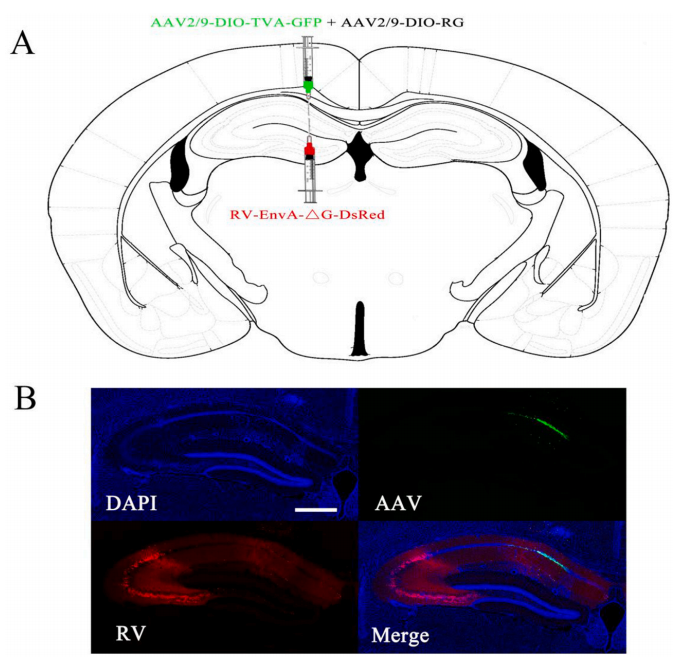AAV helper and RV were used for tracking the upstream regions of CA1. (From
BrainVTA)
The viruses used in this article from BrainVTA are in the table below
|
Tracing Helper |
PT-0062 rAAV-Ef1α-DIO-EGFP-2a-TVA-WPRE-pA
PT-0023 rAAV-Ef1α-DIO-RVG-WPRE-pA |
|
RV |
R01002 RV-EnvA-△G-DsRed |
Nanxi Bi, Jinjun Ding, Rongxin Zou, Xiaozhen Gu, Zhi-Hua Liu, Hui-Li Wang
Pub Date: 2021-07-07,
DOI: 10.1016/j.taap.2021.115641,
Email: sales@brainvta.com
Bisphenol-A (BPA) is an environmental endocrine disruptor and impairs learning and memory. However, the direct evidence for BPA exposure affecting neural circuits has been limited. In this study, a virus tracing assay has been established to explore the brain's neural circuits. Thy1-Cre mice were used to investigate the effects of BPA on the neural projection of glutamatergic pyramidal neurons in hippocampal CA1 based on Thy1 promoter. These transgenic mice were orally exposed to BPA (0, 0.5 mg/kg/day) from postnatal day (PND) 0 to PND60 and then subjected to behavioral tests. Morris water maze(MWM)and Barnes maze's showed that the spatial memory was seriously impaired in BPA exposed Thy1-Cre mice. Virus tracing assay indicated that CA1 pyramidal neurons mainly received neural inputs from hippocampal CA3, entorhinal cortex (EC), and medial septum (MS). The analysis showed that BPA reduced the number of RV+ neurons in CA3 and EC but not MS. The immunohistochemistry experiment displayed that BPA decreased the percentage of CaMKIIRV+ cells in CA3 and EC. The results demonstrated that the synaptic connection of upstream glutamatergic neurons and CA1 pyramidal cells was weakened by BPA exposure. These point to potentially detrimental effects of BPA exposure on the excitatory neural circuit of CA3-CA1 and EC-CA1 in memory formation. Thus, our findings revealed that the decrease in excitatory neural circuits of CA3-CA1 and EC-CA1 contribute to the BPA-induced spatial memory deficits in Thy1-Cre mice.
 Figure 1. Injection site of virus in CA1 of Thy1-Cre mice.
Figure 1. Injection site of virus in CA1 of Thy1-Cre mice.
In this study, combined behavioral experiments, viral tracing, and immunohistochemistry assays, the potential mechanism was investigated that BPA reduced spatial memory in Thy1-Cre mice via inhibition of CA3-CA1 and EC-CA1 excitatory projection. The results will shed light on the possible mechanism of how BPA impacts behaviors and critical functions of the brain at the neural circuit level.
BrainVTA offers viral vector construction & virus packaging services for AAV, LV, RABV, PRV, HSV and VSV that help researchers explore questions about genes, neurons, circuitry structure, function of brain network, mechanism and treatment of diseases.
If you have any needs, just email us at
sales@brainvta.com.
